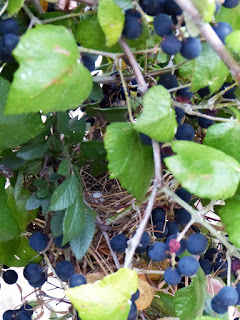Until recently I thought muscat, muscadine and mustang all referred to the same type of wild grape. It turns out I was sorely mistaken. I helped a fellow resident pick wild grapes from my vines so she could make some ice cream from them for our city's ice cream social earlier this month. While she was was researching recipes she asked me if muscadine and mustang grapes were the same thing. At the time I thought so but based on the resources she found, I began to question if that was correct. While not part of our discussion, I thought I remembered muscat being used as a short version of muscadine and I decided I should look into that too.
Mustang versus Muscadine: Both grapes are native to the Southern United States with quite a bit of overlap in their native ranges. Mustang grapes are purple as well as some varieties of muscadine. Both grapes mature into large vines that climb trees or any other object near them and are drought tolerant and have low chilling requirements. There are noticeable differences between them however. Mustang grapes mature earlier. They are much more acidic. When I eat fresh mustang grapes off the vine, I squirt the gelatinous inner flesh into my mouth and discard the skins because of the reaction I had from eating the whole grape. The skins have a complex flavor when cooked however and contain a lot of pectin. The ice cream my friend made from the cooked skins was yummy. And beware, neither type is seedless. Compared to mustang grapes, muscadine grapes are sweet. They are used to make wine, jams and jellies. Mustang grapes can also be used in the same way, however the flavor profiles are very different. You can also tell the two grapes apart from their leaves. Mustang leaves are fuzzy on both sides and the bottom of their leaves are whitish. Muscadine leaves have little or no fuzziness. The first photo in this post is of a young section of mustang vine when the leaves are fuzziest and often three lobed. As they mature the leaves lose some fuzziness and their lobes as seen in the second photo along with some ripe fruit.
As for muscat grapes. They are an old world family of grapes not to be confused with our native North American muscadine and mustang grapes.
Friday, July 27, 2018
Muscat, Muscadine, Mustang
Labels:
muscadine grapes,
muscat grape,
mustang grape
Tuesday, July 17, 2018
Pile of Feathers
As I drove past our park today I noticed a large, scattered pile of bird feathers. I recognized I was looking at the aftermath of a recent raptor kill. Several years ago upon turning down our driveway we saw a Cooper's hawk with a fresh kill and watched while it plucked and then flew away with the bird it had dispatched.
I drove home and got my camera so I could document my discovery. There are several birds that came to mind when I saw the gray feathers tipped in white. My first thought was mockingbird. However, upon looking up mockingbird feathers, the white and black boundary on the feathers seems too straight for a mockingbird. My next thought was dove. We have three types of dove commonly in our area, mourning dove, Eurasian collared dove and white-winged dove. After looking up feather images of all three, I feel confident that the bird feathers are from a white-winged dove.
As for the raptor, there are four hawks that I have seen in Dalworthington Gardens who prey on birds. The largest, the red-tailed hawk, is known for catching rodents and other small mammals more than birds so I think this one is not the most likely hunter. The other three hawks are red-shouldered hawk, sharp-shinned hawk and Cooper's hawk. I have seen a dove explode out of a hedge row with a small hawk on its tail. They were moving so fast and I am not quick to ID the smaller hawks so I do not know which of the three that was but I am guessing one of them was responsible for the pile of feathers I spied today. The Audubon distribution maps put sharp-shinned hawks further north for breeding season and birds seem to be a smaller part of a red-shouldered hawk's diet than the other two, so I am going to guess the hunter was a Cooper's hawk like I saw in my driveway several years ago.
I drove home and got my camera so I could document my discovery. There are several birds that came to mind when I saw the gray feathers tipped in white. My first thought was mockingbird. However, upon looking up mockingbird feathers, the white and black boundary on the feathers seems too straight for a mockingbird. My next thought was dove. We have three types of dove commonly in our area, mourning dove, Eurasian collared dove and white-winged dove. After looking up feather images of all three, I feel confident that the bird feathers are from a white-winged dove.
As for the raptor, there are four hawks that I have seen in Dalworthington Gardens who prey on birds. The largest, the red-tailed hawk, is known for catching rodents and other small mammals more than birds so I think this one is not the most likely hunter. The other three hawks are red-shouldered hawk, sharp-shinned hawk and Cooper's hawk. I have seen a dove explode out of a hedge row with a small hawk on its tail. They were moving so fast and I am not quick to ID the smaller hawks so I do not know which of the three that was but I am guessing one of them was responsible for the pile of feathers I spied today. The Audubon distribution maps put sharp-shinned hawks further north for breeding season and birds seem to be a smaller part of a red-shouldered hawk's diet than the other two, so I am going to guess the hunter was a Cooper's hawk like I saw in my driveway several years ago.
Saturday, July 14, 2018
Design This - Exhibit Related Jewelry
 For a few years now I have provided the Arlington Museum of Art with some small batch, true wholesale products when I can
For a few years now I have provided the Arlington Museum of Art with some small batch, true wholesale products when I can  produce something in the way of jewelry, accessories, note cards or home decor that compliments one of their major exhibits. Their current exhibit, Cut! Costume and the Cinema showcases five centuries of period costumes designed for movies. While the timeline of the costumes is long, the costumes that inspired my designs based on materials I had on hand were the Victorian dresses.
produce something in the way of jewelry, accessories, note cards or home decor that compliments one of their major exhibits. Their current exhibit, Cut! Costume and the Cinema showcases five centuries of period costumes designed for movies. While the timeline of the costumes is long, the costumes that inspired my designs based on materials I had on hand were the Victorian dresses. I have a small charm of a lady in a dress resembling those of the Victorian era. I made some earrings and necklaces out of these. I also had some larger fan charms that I used to craft an artistic interpretation of the dresses of this period and turned them into earrings and necklaces too. Just before the show opened, I was at a trade show and found just a few larger pirate themed charms that went wonderfully with the Pirates of the Caribbean costume that Johnny Depp wore. I made necklaces out of these.
I have a small charm of a lady in a dress resembling those of the Victorian era. I made some earrings and necklaces out of these. I also had some larger fan charms that I used to craft an artistic interpretation of the dresses of this period and turned them into earrings and necklaces too. Just before the show opened, I was at a trade show and found just a few larger pirate themed charms that went wonderfully with the Pirates of the Caribbean costume that Johnny Depp wore. I made necklaces out of these.The exhibit at the Arlington Museum of Art runs through August 12, 2018. If you are a movie buff, a seamstress or costume designer, you will especially enjoy this exhibit. Tip: Don't wait until the last weekend to view this exhibit. That weekend usually is pretty crowded.
Saturday, July 7, 2018
Grape Harvest Interrupted When a Nest is Found
A couple of nights ago I was helping a friend pick some of my muscadine grapes when all of a sudden I realized that what I thought was a tangle of vines and branches was actually a bird's nest and it was occupied by an intact egg. I had been clipping grape clusters below the tangle but stopped as soon as I discovered the nest. I did not want to through off the balance of the nest by lightening the vines by removing grapes. They were also offering important cloaking for the nest. I did get a couple of pictures before moving my ladder to another section of the wild grape vines to continue harvesting.
Even if I was not all that interested in protecting what I hope is a viable egg in the bird nest, I would have had to leave it be until the egg hatched and baby bird fledged or until enough time had passed to be able to determine that the nest was abandoned and the egg was not viable. With the exception of a few officially designated pest bird species, all bird nests and eggs are protected by federal law in the form of the Migratory Bird Treaty Act. In addition some states, counties and communities have additional protections on the books.
Texas Parks and Wildlife has some good information about what to do if you encounter what you think might be abandoned wildlife. Numbers seven and ten in this link have some additional good suggestions regarding discovered nests.
I am not well versed in egg identification. If by chance these pictures give you a hint as to what type of bird laid this egg, please let me know in comments. Clicking on the images will bring up larger versions.
Update 7/11/18: It's a cardinal nest! I snapped this picture last night. I went to get the mail last night, looked up and saw the female's tail feathers showing so I got my camera and took some photos from the driveway. I did not want to drag out a ladder and scare mama off. I did not notice I had more than tail feathers in the shot until looking at them on my monitor.
Even if I was not all that interested in protecting what I hope is a viable egg in the bird nest, I would have had to leave it be until the egg hatched and baby bird fledged or until enough time had passed to be able to determine that the nest was abandoned and the egg was not viable. With the exception of a few officially designated pest bird species, all bird nests and eggs are protected by federal law in the form of the Migratory Bird Treaty Act. In addition some states, counties and communities have additional protections on the books.
Texas Parks and Wildlife has some good information about what to do if you encounter what you think might be abandoned wildlife. Numbers seven and ten in this link have some additional good suggestions regarding discovered nests.
I am not well versed in egg identification. If by chance these pictures give you a hint as to what type of bird laid this egg, please let me know in comments. Clicking on the images will bring up larger versions.
Update 7/11/18: It's a cardinal nest! I snapped this picture last night. I went to get the mail last night, looked up and saw the female's tail feathers showing so I got my camera and took some photos from the driveway. I did not want to drag out a ladder and scare mama off. I did not notice I had more than tail feathers in the shot until looking at them on my monitor.
Subscribe to:
Comments (Atom)










